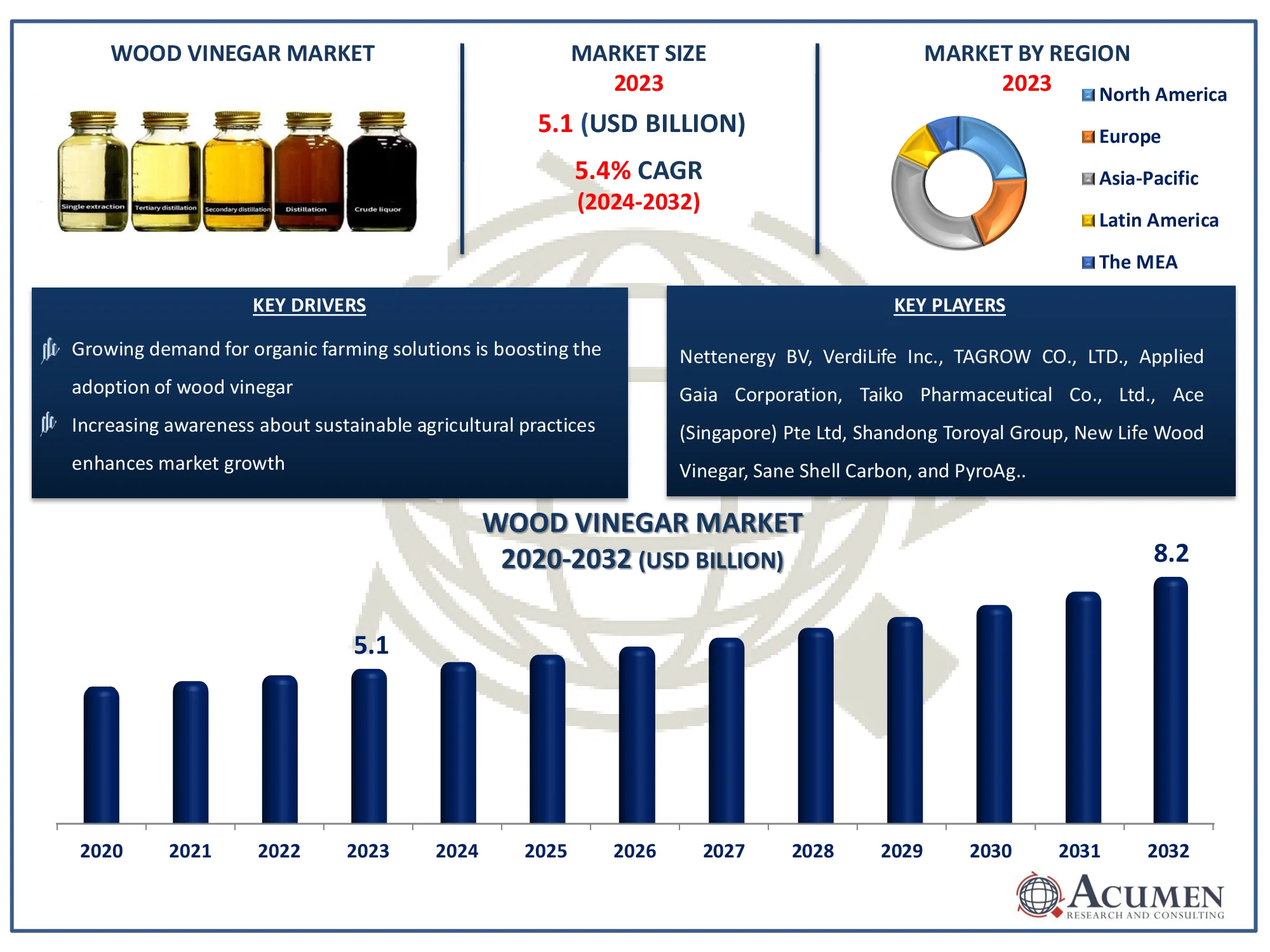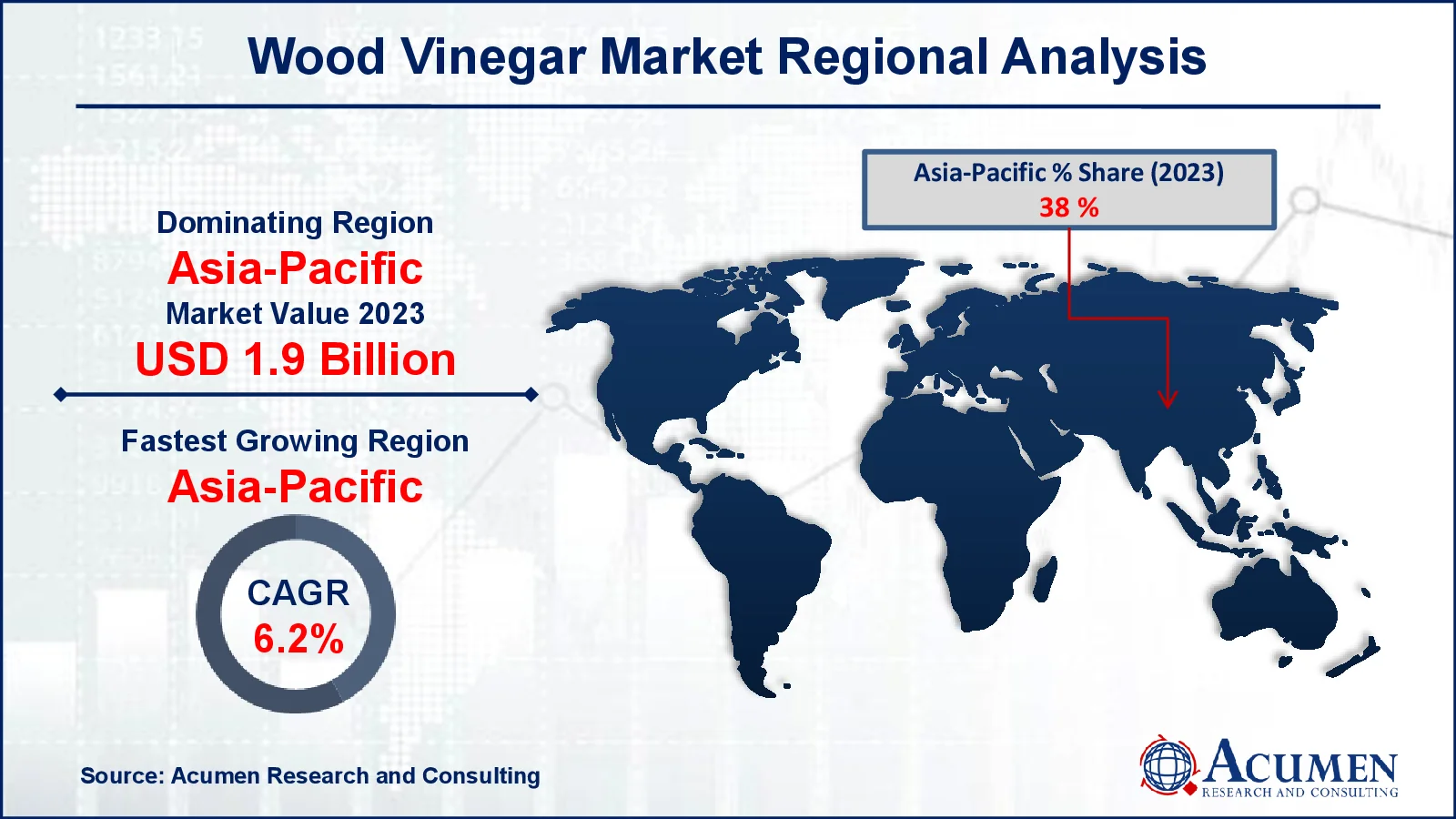Wood Vinegar Market | Acumen Research and Consulting
Wood Vinegar Market Size - Global Industry, Share, Analysis, Trends and Forecast 2024 - 2032
Published :
Report ID:
Pages :
Format :
The Global Wood Vinegar Market Size accounted for USD 5.1 Billion in 2023 and is estimated to achieve a market size of USD 8.2 Billion by 2032 growing at a CAGR of 5.4% from 2024 to 2032.
Wood Vinegar Market Highlights
- Global wood vinegar market revenue is poised to garner USD 8.2 billion by 2032 with a CAGR of 5.4% from 2024 to 2032
- Asia-Pacific wood vinegar market value occupied around USD 1.9 billion in 2023
- Asia-Pacific wood vinegar market growth will record a CAGR of more than 6% from 2024 to 2032
- Among process, the slow pyrolysis sub-segment generated USD 3.5 billion revenue in 2023
- Based on application, the agriculture sub-segment generated 42% wood vinegar market share in 2023
- Technological advancements in wood vinegar production can reduce costs and improve quality is a popular wood vinegar market trend that fuels the industry demand

Wood vinegar is a by-product of charcoal production. It is a liquid produced by gas and burning fresh wood in airless condition, and condenses into a liquid when the gas is cooled. The major components of wood vinegar are acetone, acetic acid, and methanol. Additionally, wood vinegar contains 80%-90% water along with some 200 organic compounds. Furthermore, raw wood vinegar also contains more than 200 chemicals, including methanol, formaldehyde, tar, acetic acid, ethyl-valerate, and others. Wood vinegar improves the quality of the soil, eliminates pests and controls the growth of plants; it is slightly toxic to fish and very toxic to plants if large quantity of wood vinegar is applied. It speeds up roots, stems, tubers, leaves, flowers and fruit growth.
Global Wood Vinegar Market Dynamics
Market Drivers
- Growing demand for organic farming solutions is boosting the adoption of wood vinegar
- Increasing awareness about sustainable agricultural practices enhances market growth
- Wood vinegar’s role in improving soil fertility drives its usage in the agricultural sector
- Rising applications in animal feed as a natural additive fuel market expansion
Market Restraints
- Limited awareness among farmers about wood vinegar’s benefits hinders market penetration
- High production costs restrict its widespread adoption in cost-sensitive markets
- Inconsistent quality and standards across manufacturers affect product reliability
Market Opportunities
- Expanding organic farming sector presents new growth avenues for wood vinegar producers
- Increasing government incentives for sustainable agriculture boost market prospects
- Growing interest in eco-friendly pest control solutions opens new application areas
Wood Vinegar Market Report Coverage
| Market | Wood Vinegar Market |
| Wood Vinegar Market Size 2022 |
USD 5.1 Billion |
| Wood Vinegar Market Forecast 2032 | USD 8.2 Billion |
| Wood Vinegar Market CAGR During 2023 - 2032 | 5.4% |
| Wood Vinegar Market Analysis Period | 2020 - 2032 |
| Wood Vinegar Market Base Year |
2022 |
| Wood Vinegar Market Forecast Data | 2023 - 2032 |
| Segments Covered | By Process, By Application, And By Geography |
| Regional Scope | North America, Europe, Asia Pacific, Latin America, and Middle East & Africa |
| Key Companies Profiled | Nettenergy BV, VerdiLife Inc., TAGROW CO., LTD., Applied Gaia Corporation, Taiko Pharmaceutical Co., Ltd., Ace (Singapore) Pte Ltd, Shandong Toroyal Group, New Life Wood Vinegar, Sane Shell Carbon, and PyroAg. |
| Report Coverage |
Market Trends, Drivers, Restraints, Competitive Analysis, Player Profiling, Covid-19 Analysis, Regulation Analysis |
Wood Vinegar Market Insights
Increasing government regulations on the use of crop protection chemicals, need for increased cropping yields and increasing acceptance of organic food products by people are the key factors which are likely to drive the wood vinegar market growth during forecast period and lead to development of economy. Another factor that is anticipated to boost the development of this market is the increasing demand for wood vinegar in pharmaceutical and cosmetics industry.
In addition, the growing use of wood vinegar among multiple sectors, the efficient production of wood and increasing use of wood vinegar in food industry are some significant considerations which are expected to promote food market growth in the near future. This development of industry is anticipated to increase during the wood vinegar market forecast period. However, limited number of manufacturers and stringent government policies and regulations are the major factors that restrict the global market growth. Lack of awareness regarding the health benefits of wood vinegar is anticipated to hamper the development of the market in the near future, particularly in emerging nations.
Consumption of Wood Vinegar
- The Organic Agriculture – Wood vinegar is extremely suitable for use in organic farming as it is a natural organic compound. In agriculture, a large number of toxic chemicals have been replaced by wood vinegar, a natural product used to promote growth and yield for crops such as rice, oriza sativa, sweet potato, Ipomoea batatatas, sugar cane, saccharum officinarum, melon, Cucumismelo. It has also been used to improve fruit quality, fight diseases and pests, speed up germination of plate seeds and serve as herbicides.
- Alternative Medicine - Wood vinegar promote balance and increased body healing. A variety of sources such as chemical pesticides and food fertilizers, contaminated air as a byproduct from metabolism could accumulate toxin in the body. As weakness, pain and distress, illness, and disease are the result of continued accumulation of toxin. For instance, Gout, arthritis, rheumatism and back pain are common illnesses caused by body toxins. Regular removal of toxins can therefore lead to good health. In the preparation of detoxifying pad available in Japan, USA, Korea and China, carbonization wood vinegar has been used.
- Food Processing - Wood vinegar is a natural food additive used as additives and preservatives. In processed foods, phenols and shot chains of organic acids containing vinegar can be used to prevent growth of microbials. Furthermore, wood vinegar extracted smoke flavors were also used as safety products for food. In addition, the United States. For smoke flavor and food preservation, such as ham, sauce, bacon, sausage, fish and cheese, the Food and Drug Administration permits use of pyrolysesic acid.
Wood Vinegar Market Segmentation
The worldwide market for wood vinegar is split based on process, application, and geography.
Wood Vinegar Market By Process
- Fast Pyrolysis
- Slow Pyrolysis
- Intermediate Pyrolysis
According to wood vinegar industry analysis, slow pyrolysis is the primary process that generates significant money. This approach comprises the thermal breakdown of biomass at lower temperatures (about 400°C) and extended residence durations, usually several hours. Slow pyrolysis yields more liquid byproducts, such as wood vinegar, than fast and intermediate pyrolysis, which favor charcoal or gas generation. The longer process time allows for a more controlled breakdown of organic material, resulting in a higher-quality wood vinegar high in acetic acid and beneficial components. Slow pyrolysis is widely used in agricultural applications such as soil enhancement, insect management, and organic farming because to its improved yield and quality, which accounts for a considerable wood vinegar market share.
Wood Vinegar Market By Application
- Agriculture
- Animal Feed
- Food, Medicinal, and Consumer Products
- Other
Among wood vinegar applications, agriculture sector accounts for the largest share in the global wood vinegar market. Wood vinegar is a light brownish liquid produced by natural carbonization. Mostly it is used in agriculture as a fertilizer, and pesticide with a wide range of benefits such as strengthens roots and leaves, the quantity of microbes, stimulates plant and vegetable growth, improved absorption within the roots, repels pests and insects, prevents plant infection from fungal, bacterial diseases and viruses. Wood vinegar reduces the value of water in the cluster by 1/3. Due to its small mass, water is activated and easily absorbed by plants and animals. There are one or more mineral elements in each of these masses. These elements are easily absorbed by plants and the use of agrochemicals is greatly reduced. However, alkaline chemicals should not be combined.
Wood Vinegar Market Regional Outlook
North America
- U.S.
- Canada
Europe
- U.K.
- Germany
- France
- Spain
- Rest of Europe
Asia-Pacific
- India
- Japan
- China
- Australia
- South Korea
- Rest of Asia-Pacific
Latin America
- Brazil
- Mexico
- Rest of Latin America
The Middle East & Africa
- South Africa
- GCC Countries
- Rest of the Middle East & Africa (ME&A)

Wood Vinegar Market Regional Analysis
The wood vinegar market analysis is provided for major regional markets including North America, Europe, China, Japan, Southeast Asia, India, South America, Middle East & Africa followed by major countries. For each region, the market size and volume for different segments has been covered under the scope of report. The Asia-Pacific region accounted for significant wood vinegar market share and over the forecast period is expected to grow at a high CAGR. This is due to the consumer's acceptance in this region for wood vinegar as an essential natural agricultural input.
Wood vinegar is also used as a bio-pesticide; as it minimize the environmental risk. In addition, the increasing demand for organic farming in this region is expected to have a positive impact on the wood vinegar market. It is produced locally as a substitute for low-cost synthetic chemicals. An additional growth factor for the wood vinegar market in Asia-Pacific is the increasing adoption of organic food.
Wood Vinegar Market Players
Some of the top wood vinegar companies offered in our report include Nettenergy BV, VerdiLife Inc., TAGROW CO., LTD., Applied Gaia Corporation, Taiko Pharmaceutical Co., Ltd., Ace (Singapore) Pte Ltd, Shandong Toroyal Group, New Life Wood Vinegar, Sane Shell Carbon, and PyroAg.
Frequently Asked Questions
How big is the wood vinegar market?
The wood vinegar market size was valued at USD 5.1 billion in 2023.
What is the CAGR of the global wood vinegar market from 2024 to 2032?
The CAGR of wood vinegar is 5.4% during the analysis period of 2024 to 2032.
Which are the key players in the wood vinegar market?
The key players operating in the global market are including Nettenergy BV, VerdiLife Inc., TAGROW CO., LTD., Applied Gaia Corporation, Taiko Pharmaceutical Co., Ltd., Ace (Singapore) Pte Ltd, Shandong Toroyal Group, New Life Wood Vinegar, Sane Shell Carbon, and PyroAg.
Which region dominated the global wood vinegar market share?
Asia-Pacific held the dominating position in wood vinegar industry during the analysis period of 2024 to 2032.
Which region registered fastest CAGR from 2024 to 2032?
Asia-Pacific region exhibited fastest growing CAGR for market of wood vinegar during the analysis period of 2024 to 2032.
What are the current trends and dynamics in the global wood vinegar industry?
The current trends and dynamics in the wood vinegar industry include growing demand for organic farming solutions is boosting the adoption of wood vinegar, increasing awareness about sustainable agricultural practices enhances market growth, wood vinegar’s role in improving soil fertility drives its usage in the agricultural sector, and rising applications in animal feed as a natural additive fuel market expansion.
Which application held the maximum share in 2023?
The agriculture application held the maximum share of the wood vinegar industry.



